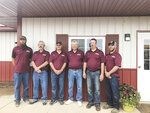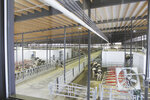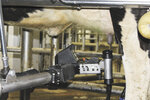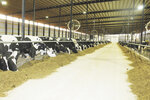



COLBY, Wis. — A project that began several years ago and has encompassed hundreds of hours of careful planning and consideration became a reality at Heeg Brothers Dairy when the family entered the world of robotic milking.
Three generations of the Heeg family work together on the farm. Brothers Mark, Gary and Jay are partners in the operation. Their father, August, remains active on the farm, hauling tankers of milk from the farm to Mullins Cheese four days a week. The farm was established in 1999 when the herds owned by August and Mark were combined at one facility.
Mark’s son, Nathan, and Gary’s son, Cory, work on the farm full time and are in the process of transitioning into ownership. Jay’s daughter, Jazmyn, helps on the farm and will be attending the University of Wisconsin-River Falls in the fall to major in dairy science.
The Heegs farm 3,300 acres, growing all the forages needed to feed their milking herd and youngstock.
On Dec. 5, 2023, eight DeLaval VMS-300 robotic milking units in two pens were turned on for the first time. The Heegs are milking 450 cows in the robotic facility and an additional 1,000 cows in their existing double-14 parallel parlor.
“We will keep milking in the parlor for the foreseeable future, but this gives us the capability that if we want to invest in something, it would be in robotics,” Jay Heeg said. “The robotics more closely meet the goals we have for our family down the road.”
The Heegs are opening their farm for visitors April 12 to share their experience of introducing robots.
“The future of the technology was interesting to us,” Heeg said. “It is a whole different philosophy for cow management.”
Driven by labor concerns and a desire to increase the use of technology, the Heegs began investigating their options over three years ago.
“We did a lot of touring, looking at both robot and rotary barns,” Heeg said. “We really liked the cow environment in the robot barns, the style of the life they live out there. They are on their own. They decide what they like to do. The cows are so calm and quiet.”
The Heegs determined that the DeLaval robots were the best fit and spent the next year planning the future of their farm.
“We really liked the guided-flow system,” Heeg said. “The cow comfort we saw sold us, and we have a lot of confidence in our relationship with Bob’s Dairy Supply.”
The Heegs chose to work with Fox Cities Builders to construct their tunnel-ventilated robotic barn.
“The planning process went really well,” Heeg said. “They were excellent in helping us lay out our robot barn. … The quality of the work was great. We are very happy with what they built. The process was seamless.”
Heeg described the planning process as intense but positive.
“It’s so important,” he said. “You don’t want any surprises after. We met every week and went over every single detail, every doorknob, every window, everything.”
The robotic barn was built as the first phase of a three-part plan.
“We designed the barn to be added on to so that it could have up to 24 robots,” Heeg said. “We’re at two pens of eight robots. We’re not even to the peak of the building yet.”
When the time came to start up, the Heegs were surprised at how smoothly their cows transitioned from the parlor to the robots. They started one pen with 160 cows and started the second pen two weeks later.
The cows sent to the robotic facility were selected based on udder scores, feet and legs, and milking speed. Cows from all stages of lactation were selected to create a herd dynamic. After a month, groups of 30 fresh cows were added every other week until each pen was full.
“I was nervous,” Heeg said. “I didn’t know how the cows would learn all the sort gates and robots, but they did really well. The cows learned faster than the people. The cows are settled in, but we’re still learning.”
Because of his admiration for the calmness of the cows milked by the robots, Heeg said they try to only work with the cows in the sort pens, staying out of the free stalls as much as possible. The exception is the addition of sand bedding once a week.
“We don’t want to do anything to disrupt the flow out in the barn,” Heeg said.
In a short three months, Heeg said the investment in the robotic milking facility has exceeded their expectations. The cows have achieved a 95-pound milk average with a 4.2% butterfat test. Most impressive to Heeg was the somatic cell counts from the cows being milked in the robots. The cows are averaging 2.8 visits, with no pellets being fed in the robots.
“The first load of milk we sent out had a SCC of 110,000,” Heeg said. “Within two weeks, it was down to 65,000. Now, we’re currently at 70,000, which is half of what the parlor is. That proves the milking process is very good and is important to udder health.”
Heeg said his family has no regrets about their decision to invest in robots and has been thrilled with the results.
“Once the cows are trained, they do better without you out there in the pen,” Heeg said. “You just let them do their own thing. That has been the biggest learning curve for us — to have patience and let them be. We have had to change the way we think about managing the cows. We have to learn to rely on the data provided to us.”
Comments
No comments on this item Please log in to comment by clicking here